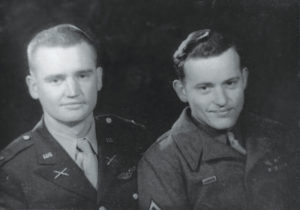
When Joe Bailey Auld entered the Army, he was trained at Sheppard Field, Texas, as a glider mechanic to serve in the 434th Troop Carrier Group, a C-47 transport unit for operations with the Ninth Air Force.
In August 1943, when he was stationed at Alliance Army Air Force Field in Alliance, Nebraska, his Group moved to Camp Kilmer, New Jersey, and prepared for overseas assignment. They boarded the Queen Mary and sailed from New York on 9 October 1943 for the British Isles, landing in Scotland. All their supplies and the Gliders (in boxes) were loaded on trucks and moved to RAF Fulbeck, England, and they were assigned to the 53rd Troop Carrier Wing, 71st Troop Carrier Squadron, 434th Troop Carrier Group.
From November 1943 through 14 May 1944, they engaged in an intensive training program with the 101st Airborne at RAF Aldermaston, England, in preparation for the invasion of northern France. On 3 March 1944, Joe received flying status, serving as glider co-pilot.
In February 1945, Joe’s unit moved to Mourmelon-le-Grand Airfield, northeast of Paris, France, where they were stationed until the end of the war. His list of battles and campaigns included Normandy, Northern France, Ardennes, Rhineland, and Central Europe.
Joe’s brother, V. L. Auld, served as Liaison Pilot with the 909th Field Artillery Battalion of the 84th Infantry Division. His training began at Ft. Sill, Oklahoma, where he received basic training and completed the Field Artillery Officer Candidate School. After completing the Liaison Pilot Course at Pittsburg, Kansas, his training continued at Ft. Sill and at Camp Howze, Texas. Then, the Division participated in the “Louisiana Maneuvers.”
In September 1944, the 84th Division received orders to report to Camp Kilmer, New Jersey, for overseas embarkation. The 335th Infantry and units of the Division Artillery boarded the Sterling Castle, an English ship. They were in a collision with another ship at sea during the first night out and had to return to port for repairs. The accident ripped a hole in the bow about 40 feet high, and all 7,000 soldiers went back to Camp Kilmer while the ship was being repaired. Then, they re-boarded the ship and headed for Southampton, England.
Since Joe was still serving in England when V. L. arrived, they met in London for one weekend. They stayed at the Savoy Hotel and managed to locate the Piccadilly Square, the Queen’s Palace, and other points of interest. They did not see each other again until they returned to Tishomingo, Oklahoma, at the end of the War.
After arriving in England, Liaison Pilots became the Air Section of the Division Artillery Headquarters, and V. L.’s job changed from Battalion Air Officer to Assistant Division Artillery Air Officer. The Liaison Airplanes (L-2s) arrived in England in crates. After assembling, they had only ten airplanes, but they had eleven pilots. The Division Air Artillery Officer, Major Paschall, did not want to ride an LST across the English Channel, so they gathered up parts from all over the United Kingdom and put together the eleventh airplane so all could fly across together.
First units of the 84th Division landed on Omaha Beach, France, on 1 November 1944 with the remainder arriving the next three days. The Germans had put up long poles on the beach to prevent the L-2s and gliders from landing. The L-2s landed on a road. However, the wind was too strong for V. L.’s plane to land, so two jeeps were sent out to help. They ran along beside his plane and grabbed the struts to pull the plane down.
Most of the units of the 84th moved through France into Belgium in less than 48 hours. They became a part of the Ninth Army and worked with the British, the 2nd Armored, and 102nd Infantry Division in the capture of a section of the Siegfried Line. After breaching the Siegfried Line, the 84th was closing in on the Roer River when the Germans launched their biggest offensive, the Battle of the Bulge.
The air strip for the L-2s was moved several times during this battle. At one point, they moved back from the front to a place just outside of Liege, Belgium, and occupied a chateau with about 20 bedrooms. The Germans were trying to hit the big ammunition dump close to Liege, and this chateau turned out to be right in the line of fire of the buzz bombs. The chateau was not hit, but one bomb landed about 15 feet from V. L.’s plane and twisted it up like you twist a newspaper.
From the Roer River to the Rhine River, it was move, shoot, and communicate. V. L.’s air strip moved several times, reaching the Rhine about 5 March 1945. Then, the plan was for the 5th Armored to drive toward the Elbe River, with the 84th Division close behind. As they moved forward, German POW Camps and camps for displaced persons were literally starving to death. General Eisenhower had made an agreement with the Russians to allow them to take the territory on the other side of the river, so the 84th sat there for several days, since they beat the Russians to the Elbe.
The war ended 8 May 1945, and the Division moved to an area near Heidelberg, Germany, and began a phase of military occupation. The Air Section (L-2s) became a courier service, more or less. In November 1945, V. L. was assigned about 200 men, and they were sent to Frankfort, Germany. From Frankfort, they traveled in boxcars to Marseilles, France, where they boarded a ship for home.
V. L., as Liaison Pilot, took part in three major battles, including the Battle of the Bulge. With an observer, he flew over the frontlines, spotted targets, and directed Artillery fire, flying 123 missions over the enemy lines.
—Submitted by Mrs. V. L. (Lorene Walker) Auld, Member
